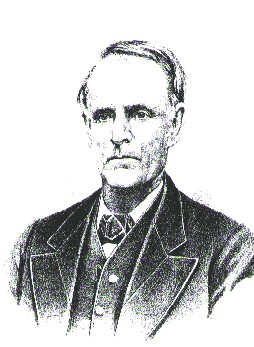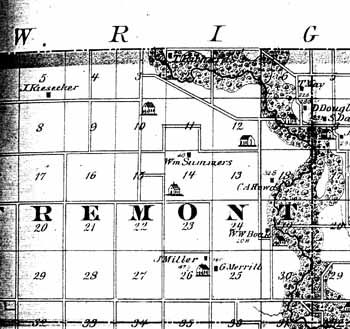Bach Grove, Hamilton County, Iowa
By Martin E. Nass
Transcribed for the IAGenWeb Project by Janelle Martin, with permission of Martin "Ed" Nass.
The Boone River enters Hamilton County from Wright County in Section 3 of what is now Fremont Township. This region was a popular hunting ground for Indians because of the 1100 acres of timber and the river. When the settlers began coming to this part of the county, they discovered three log cabins which belonged to bachelor hunters and trappers. One was north of the river and the other two were south. Thus the area was given the name Bach Grove, sometimes spelled Batch Grove, as a contraction of Bachelor's Grove.
The river enters in the northeast corner of Section 3, then flows east through Sections 2 and 1 as it courses its way to Webster City. In the early days of our county, the entire top one-fourth was called Cass Township. J. D. Sells purchased 320 acres of wild land, 240 in Wright County and 80 in Hamilton County, before he moved here from Brown County, Ohio. He loaded up his family of 13 children and moved here in 1857, traveling in three covered wagons on a trip that took them thirty-four days. His daughter, Mary Caroline, was nine years old when they made the trip. She later described their travels where there were no roads and no fences. They traveled on the higher ground to avoid the many sloughs. The other children making the trip were Minerva, Catherine, Leonard, Barbara, Marion, Harriet, Samantha E., Frank E., Benjamin Willson, Joseph M, John B., and Edward Warren.
 
Mr. Sells worked the farm and expanded his holdings until he owned 1100 acres of land in both Wright and Hamilton County. The area was officially recognized on June 19, 1858, when Sells was appointed postmaster. The post office was in his cabin in Section 2. When Sells moved to the west end of Bach Grove in 1861, the post office was moved into Wright County with W. R. Middleton as postmaster. The Bach Grove post office was discontinued on August 22, 1881.
Sells was credited with being the first person in Hamilton County to raise sheep when he drove a herd of 600 to his farms. Jacob M. Funk of Webster City followed soon after with another herd of 2000 sheep.
Angus McLaughlin settled in Section 12. His wife, Catherine (Lizzy), hosted a meeting of the county supervisors on September 3, 1861, as they worked to divide up this very large township. In the forenoon, they moved the name Grove Township in recognition of Bach Grove. Later in the afternoon, they rescinded their motion and changed it to Fremont.
The mode of travel between Webster City and Bach Grove followed the White Fox Road north to what is now 180th Street. Then the trail turned west to pass through the McLaughlin Ford until it reached what is now Fisher Avenue. From here, according to the 1875 atlas, the trail went diagonally to the west end of Bach Grove. Another road intersected this trail in the middle of Section 2 and went straight north to cross the river at Olmstead's Ford and then continued north along what is now called Evans Avenue and thence on to Goldfield. The stagecoach, which traveled between Webster City and Goldfield one a week in good weather, traveled this path.
News from Bach Grove appearing in the Hamilton Freeman included these accounts. On November 5, 1857. "Bach Grove sent down a large delegation of 'true' Republicans for a convention which was held at Cheney House, where Cyrus C. Carpenter of Fort Dodge was nominated for State Representative." (Carpenter later became governor of Iowa)
The wedding of Miss Catherine McLaughlin to Mr. David Douglass was held in Bach Grove on Nov. 28th officiated by Rev. David Power Day.
In the July 24, 1872, paper it was announced that the Republicans and Grant men in Bach Grove are preparing to organize a Grant and Wilson Club and a club of "Tanners and Cobblers."
In March 10, 1878, it was announced that the schedule for the side mails leave Webster City for Bach Grove, Goldfield, and Luni on Mondays and Thursdays at 8:00 a.m. and return the following days.
The February 8, 1882, Freeman announced the closing of the post offices at Bach Grove and Callanan. The readers were instructed to address their mails to Eagle Grove and Ellsworth respectively.
The land ownership records in 1870 show 17 families as residents of Bach Grove. The 1875 Atlas shows a school in Section 12 on the McLaughlin farm. By 1878 the Bach Grove School had been built in Section 2. This school shows up in the map accompanying this article. It was located south of the river on the east side of the road crossing Olmstead's Ford.
Since many of the children attending the school lived on the north side of the river, access was a problem. This was solved in two different ways. The Marshalltown Times-Republican editor reported meeting Lizzie Richards in his office in 1924 when she asked him, "Do you remember me?" Lizzie then related that she attended the Bach Grove School when he, Mr. Moscript, was the teacher in 1878. She crossed the river by rowboat each day, as did other children in the area. At a later time, the parents of the children constructed a swinging bridge across the ford so their children could cross over safely. The abutments for this bridge remain in place today. Mr. Moscript reported that his salary for teaching was $25 a month and he paid $7.50 for his room and board.
In 1891 J. D. Sells and his wife moved to Webster City to a house that stood where the Catholic Church now stands. They were in ill health and were cared for by their daughter, Mary Caroline, who never married. Sells died on February 6, 1892 and his wife died five years later. Both are buried in Graceland Cemetery.
Today, much of the Bach Grove area is owned by Richard Stark, Clarence Hildebrand, Winfred Walker, Geise Family Farms, Robert Kastler, DeWayne Anderson, Danny Mickelson, and the Charlotte Hoyt Ross Trust. The J. D. Sells home still stands today west of the river, on the north side of the county line road in Wright County. Olmstead's Ford crossed the river about where the pond west of the Stark home is located. The school house was located just south of that location. Much of former Bach Grove is now being converted into a park-like setting by Richard Stark.
|